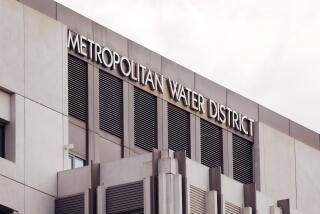Water conservation’s other benefit: It’s a power saver
California’s drought has everyone talking about ways to save water. Gov. Jerry Brown has implored residents to reduce their consumption by 20%. One writer suggested Angelenos share showers. A nonprofit is encouraging people not to waste even ice cubes that drop to the floor: Don’t toss them, says Save Our Water, use them to water plants.
Our conservation efforts, even the tiniest ones, have a second overlooked benefit: They also save energy. Water is essentially liquid energy. We don’t think about it that way. But every drop must be moved, treated and heated. Each step takes energy. In fact, 80% of the operating costs of a typical water utility are energy-related.
Consider, for a moment, a daily hot shower. If you’re a Southern Californian, your shower water might be pulled from, say, Lake Havasu, conveyed over two mountain ranges, treated and pumped to your home. It then has to be heated and, finally, after flowing down your drain, treated again.
What if Los Angeles residents exceeded Brown’s goal and dropped their daily average water consumption — currently 152 gallons per person — to below 80 gallons? That’s not outrageous; it is, in fact, the average water use in bustling, modern Sydney, Australia.
According to our calculations, this would conserve a lot of energy — about as much as is generated by a medium-sized power plant. For instance, Los Angeles could save so much energy that its Department of Water and Power wouldn’t need the electricity from one of the three coal-burning units at the Navajo Generating Station in Page, Ariz., which was recently ranked the eighth most polluting power plant in the country.
The energy cost of water also varies by locale. Water transported to Southern California is almost three times as energy intensive as water moved in the northern part of the state. Likewise, it’s more expensive to bring water to houses atop the Hollywood Hills than to those in the flatlands. Some uses consume more energy as well. Watering outdoor plants, which results in no sewage treatment, demands less energy than, say, running the dishwasher.
The biggest spigot, though, is the agricultural sector, which consumes 80% of the state’s water. Water used for farming requires less treatment and doesn’t wind up in the sewer, so it’s less energy intensive per gallon. Still, the volume dwarfs any other water use.
The energy needed to move agricultural water exceeds the electricity used by everyone in San Diego.
How then might we conserve all of the water — and energy — sloshing around the state? We could brainstorm more uses for dropped ice cubes. (More wine drinking, one colleague suggests.) Or there’s a simpler, far more efficient way to achieve the same end: Let better pricing do the work for us.
Prices convey information and shape behavior. When something is cheap, as with water, people waste it. But when it’s dear, like gasoline, we conserve. Few of us leave our cars running outside while we shop for groceries, but lots of us forget to reset sprinklers for rain or drought. Dynamic pricing — prices that rise during drought periods and fall during wet periods — would drive conservation of this energy-intensive resource when it’s scarce.
Water policy now falls short of that ideal. Water managers, unlike energy managers, get their raw material “for free” as a result of past political decisions. They pass those savings to consumers, which sounds nice — except we don’t have a limitless supply of fresh water.
In fact, with more droughts — and some climate scientists predict we’ll see more in the future — California is likely to have very little water around to give away. Our water utilities will then need to invest large sums in energy-sucking desalination plants. The 3 million residents of San Diego County, for example, are already on the hook for the $1-billion desalination plant under construction in Carlsbad.
That plant will supply less than 10% of the region’s residential water, meaning ratepayers will be out over $300 per person for what amounts to extra sprinkler water — and that doesn’t include the cost of the energy needed to run the plant. Desalination demands two times more energy than cleaning wastewater for reuse and four times more than pumping groundwater. The Carlsbad plant will use the same amount of electricity as 125,000 California homes.
So start saving water. More important, encourage lawmakers to adopt policies that reflect our water scarcity and prompt people to use less water and less energy. We face a choice of paying more for water now — or paying a lot more later.
Catherine Wolfram is a professor of business administration at UC Berkeley’s Haas School of Business and co-director of the Energy Institute at Haas. David Zetland is a visiting lecturer at Simon Fraser University, Vancouver, Canada, and the author of “Living with Water Scarcity.”
More to Read
Sign up for Essential California
The most important California stories and recommendations in your inbox every morning.
You may occasionally receive promotional content from the Los Angeles Times.









